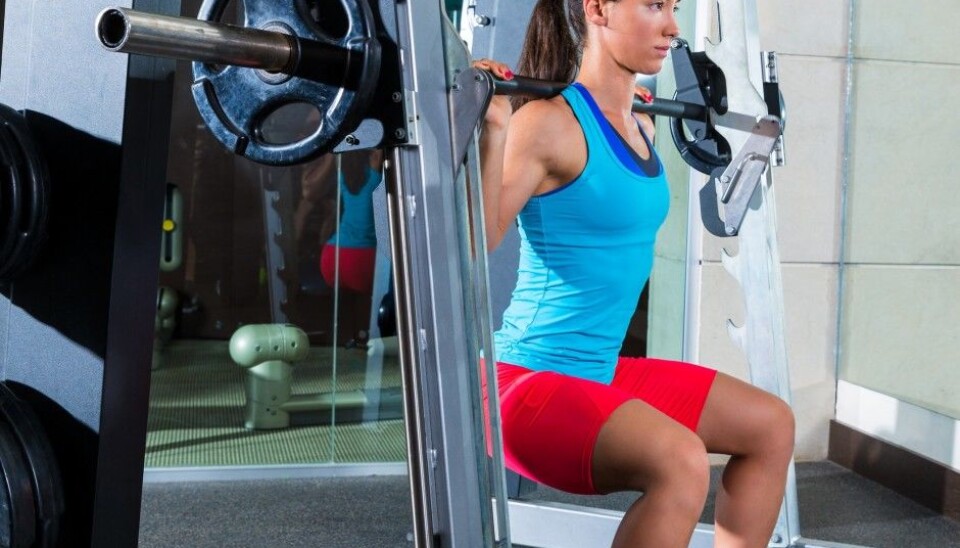This article was produced and financed by The Norwegian School of Sport Sciences

Better endurance with strength training
Traditionally, endurance athletes want to avoid gaining muscle mass. But a new study shows that bigger muscles are important to get a positive effect on achievement, especially for cyclists.
Denne artikkelen er over ti år gammel og kan inneholde utdatert informasjon.
Research fellow Olav Vikmoen from The Norwegian School of Sport Sciences has studied the effects of heavy strength training on endurance sports like cycling and running in female endurance athletes.
Nineteen highly trained female athletes, both runners and cyclists, were involved in the study. The subjects were randomly assigned to perform their usual endurance training routine or to combine their usual endurance training routine with a strength training program.
The strength training program consisted of four leg exercises which were selected to improve cycling and running performance. Over 11 weeks, the strength training group performed three sets of 4-10 repetitions for all four leg exercises. The program consisted of two sessions per week.
Tests for cycling and running
"Strength training resulted in improved running and cycling economy and improved utilization of maximal oxygen uptake - VO2 max," says Vikmoen.

The study shows that larger muscles were a key factor in order to achieve a positive effect on performance, especially in cycling. "Even though the strength training group increased their muscle mass, they did not gain weight," Vikmoen adds.
The results were recorded using two tests, both for cycling and running. They first used a 40-minute all-out cycling trial in which the strength training group improved their performance significantly. They did not find any change in the control group, who did not do strength training.
The improvement achieved by the strength training group was attributed to improved cycling economy and degree of utilization. The athletes were able to utilize a higher degree of their VO2 max.
Maximal oxygen uptake did not increase but the strength training group was able to maintain a level closer to their VO2 max compared to the athletes only performing endurance training. Having improved their cycling economy, the strength training group expended less energy to maintain the same speed - they could maintain the same pace with less effort.
No results for runners
For running, they did not find strength training to have a positive effect on performance.
Secondly, they used a five-minute all-out trial immediately following a three-our cycling session. The strength training group achieved a significant improvement in this test as well. The increased performance was mainly caused by improved cycling economy during the second half of the three-hour session. Consequently, the athletes were less fatigued prior to the five-minute all-out trial.
For running, the subjects carried out a 90-minute session immediately followed by a five-minute all-out trial. Running economy remained unchanged in both groups during the 'long session' but in the all-out trial the strength training group achieved a significant improvement in performance.
Improved running performance may be ascribed to increased anaerobic capacity, a factor which also contributed to increased cycling performance.
Strength training twice per week
Endurance training will always be most important to endurance athletes. But adding 1-2 strength training sessions per week has a positive effect on performance. Previous studies have found one session per week to be inadequate. Twice per week is regarded as optimal as the athletes can benefit from the strength training without it being at the expense of their endurance training.
"More advanced cyclists or runners are more likely to utilize a strength training program," says Vikmoen. "It will not require a lot of time," he says. "The strength training sessions should not last more than 30-40 minutes and they will not affect endurance training to any greater extent," he adds.
Strength training should be carried out twice per week, focusing on the muscles that are most involved in the specific sport. For cycling and running, it would be legs. Effective exercises for cyclists would include leg press, squat and hip thrust, while runners may want to focus more on their calves and add an exercise such as calf raises. Neither cyclists nor runners should drop below 90 degrees when performing the exercises.
"Strength training should be performed using heavy resistance," says Vikmoen. It is important to use explosive movements. However, performing the exercises correctly is vital to avoid injuries. Vikmoen urges athletes to be patient: "You cannot expect to see results in just 4-5 weeks. The athletes needed to follow the program for at least 10-11 weeks before they noticed any changes."
-------------------------------------
Read the Norwegian version of this article at forskning.no
Scientific links
- Olav Vikmoen: The effects of strength training on cycling and running performance. The Norwegian School of Sport Sciences, 2015.
- Olav Vikmoen et al: Strength training improves cycling performance, fractional utilization of VO2 max and cycling economy in female cyclists. Scand J Med Sci Sports, April 2015. doi: 10.1111/sms.12468.


































